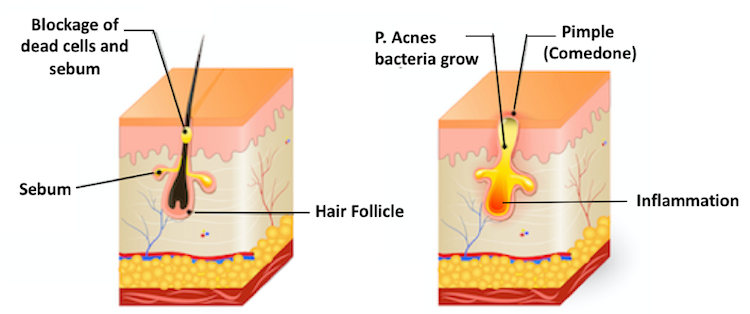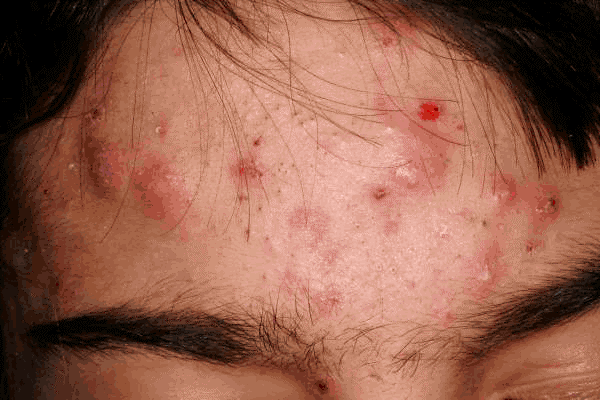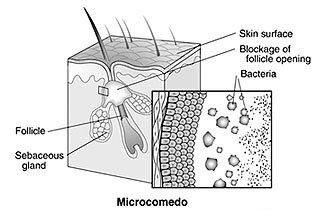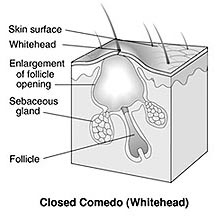Acne is a very common skin problem that shows up as outbreaks of bumps called pimples or zits. Acne usually appear on the face, neck, back, chest, and shoulders. Acne can be a source of emotional distress, and severe cases can lead to permanent acne scars.
What causes acne?
Acne begins when the pores in the skin become clogged and can no longer drain sebum (an oil made by the sebaceous glands that protects and moisturizes the skin.) The sebum build-up causes the surrounding hair follicle to swell.
Hair follicles swollen with sebum are called comedones. If the sebum stays beneath the skin, the comedones produce white bumps called whiteheads.
If the sebum reaches the surface of the skin, the comedones produce darkened bumps called blackheads. This black discoloration is due to sebum darkening when it is exposed to air. It is not due to dirt. Both whiteheads and blackheads may stay in the skin for a long time.
Bacteria called Propionibacterium acnes (P. acnes) that normally live on the top of the skin can enter the clogged pores and infect the sebum. This causes the skin to become swollen, red, and painful.
Infected sebaceous glands may burst, releasing sebum and bacteria into the surrounding skin, creating additional inflammation. In severe cases, larger nodules and cysts may form in the deeper layers of the skin.
What are the different types of acne?
Acne can be categorized by its severity:
1. Mild acne describes a few scattered comedones (whiteheads or blackheads) with minimal inflammation (no pustules).
2. Moderate acne describes a denser collection of comedones as well as red, inflamed, pus-filled lesions (pustules).
3. Severe acne, also called nodular or cystic acne, describes widespread and deep lesions that are painful, inflamed, and red. This form of acne is likely to lead to scarring if left untreated.
Who gets acne?
Anyone at any age can get acne. Acne in teenagers is very common because the surging hormone levels (androgens) associated with puberty create more active sebaceous glands. Acne in adults is is also very common, especially among women.
Acne is more likely to afflict people whose parents had acne.
What factors make acne worse?
Acne lesions can come and go. These factors can cause acne to worsen:
- Changing hormone levels in women 2 to 7 days before their menstrual period, during pregnancy, or when starting or stopping birth control pills
- Oil from skin products (moisturizers or cosmetics) or grease in the workplace (for example, a kitchen with fry vats)
- Pressure from sports helmets or equipment, backpacks, tight collars, or tight uniforms
- Environmental irritants, such as pollution and high humidity
- Squeezing or picking at blemishes
- Hard scrubbing of the skin
What acne treatments are available?
Almost all cases of acne can be effectively treated. The goal of acne treatment is to heal existing lesions, stop new lesions from forming, and prevent acne scars.
Different acne medications are available that control one or more of the underlying causes of acne. Common classes of acne medications include the following:
- Topical retinoids (Differin®, Epiduo®, Retin A Micro®, Tazorac®, or tretinoin) help unclog sebaceous glands and keep skin pores open.
- Antibiotics, such as doxycycline and minocycline (Solodyn), may be used to fight the P. acnes bacteria.
- Isotretinoin (Amnesteem®, Sotret®) remain a mainstay of treatment for severe acne by reducing sebum (oil) production.
- Hormonal agents, such as birth control pills, may be used by women to reduce sebum (oil) production .
Your doctor will prescribe acne medications based on the following factors:
- Severity of your acne. Mild acne may respond well to a topical retinoid alone. Moderate acne may respond better to a combination of topical retinoid with an antibiotic or other medication. Severe acne with scarring may need treatment with isotretinoin (Amnesteem®, Sotret®).
- Results of previous treatments. Medications may be added in a step-wise fashion, if previous acne treatments are found to be ineffective.
- Degree of scarring. More aggressive therapies may be started earlier if there already signs of acne scars.
- Gender. Some treatments are available only for women, such as birth control pills.
Non-prescription acne medications may provide sufficient results for some people with mild acne. However, most people with moderate acne and all with severe acne will need to use prescription acne medications for effective treatment.
Whatever your treatment plan, it is important that you give it enough time to work. This may mean waiting 6 to 8 weeks to see results. While the older acne lesions are healing, the medication is hard at work keeping new lesions from forming. Staying on your medication is the most important step to getting acne under control.
How can I keep my acne under control?
After your acne clears, your doctor may recommend that you continue therapy with a topical retinoids to keep it under control. It is always a good idea to maintain good skin care and use skin care products labeled as “non-comedogenic” (do not promote acne)
For ongoing acne skin care and prevention of acne, follow a few simple guidelines:
- Clean skin gently—Use a mild skin cleanser twice a day, and pat skin dry. Harsh cleansers and astring
 ents can actually worsen acne.
ents can actually worsen acne. - Do not pop, squeeze, or pick at acne lesions, as this can promote inflammation and infection. Keep hands away from your face and other acne-prone parts of the skin.
- Limit sun exposure—Tanning only masks acne at best. At worst, sun exposure can lead to skin damage, especially if you are using an acne treatment that makes your skin more sensitive to sunlight and UV rays (this includes tanning booths).
- Choose cosmetics with care—As mentioned above, choose non-greasy skin products, and look for words like “non-comedogenic,” “oil-free,” and “water-based." Some facial products contain active acne-fighting ingredients, such as benzoyl peroxide or salicylic acid, to help keep mild acne at bay.
- Be patient with your treatment—Find out how much time it should take for your acne treatment to work (generally 6-8 weeks) and then stick with it. Stopping treatment early may prevent you from seeing good results or even cause a relapse of symptoms. Your skin may look worse before it begins to improve. You may need to try more than one type of treatment.
Source: Vivacare
Last updated : 2/8/2021